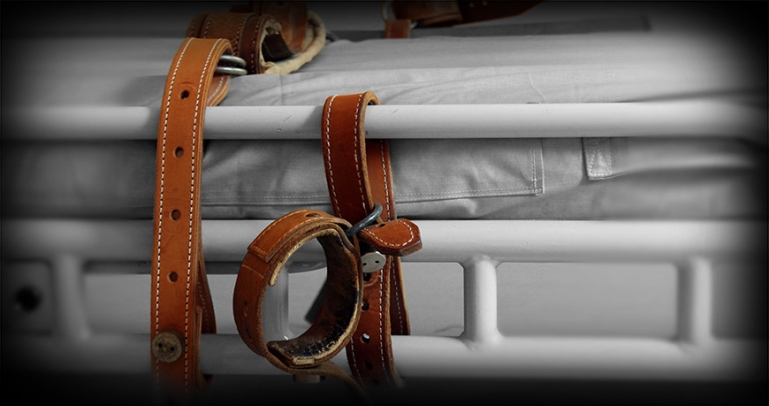DRC has long advocated for reducing and eliminating behavioral restraint

DRC has long advocated for reducing and eliminating behavioral restraint

Disability Rights California has been a state and national leader in investigating and highlighting the risks of behavioral restraint and championing legislation to prohibit dangerous practices.
1992 Death of state hospital resident after seven hours in restraint
In March 1992, Zouhair Jadeed, a 22-year-old with multiple disabilities, was found dead in a restraint bed at a state psychiatric hospital. Zouhair was restrained for nearly 8 hours face down (prone) with leather cuffs on his wrists and ankles binding him to the bedframe and a leather restraint belt at his waist. Zouhair communicated in American Sign Language. Therefore, if he was in distress, he was unable to express any difficulties that he was experiencing with his hands bound to the bed.
Although staff claimed to have been checking on Zouhair every 15 minutes as required by policy, the condition of his body suggested that he had been dead for a considerable amount of time.
In March 1993, Disability Rights California, known as Protection and Advocacy, Inc., issued a report about Zouhair’s death and sounding the alarm about the dangers of restraint. DRC was critical of the facility’s excessive and extended use of restraint and seclusion. DRC expressed concerns about reliance on restraint and seclusion to address behavioral challenges in lieu of a positive behavior plan.
1993 Man died after 18 hours in restraint, two days after being admitted to psychiatric hospital
Marc Kiefer, a 38-year-old man, was found dead at East Bay Hospital following nearly eighteen hours in locked seclusion and leather restraints. Although the staff reported checking on Marc frequently throughout the night before he died, Marc was blue in color and in rigor mortis when staff checked on him the following morning.
In March 1994, DRC issued a report about our investigation into Marc’s death. DRC recommended frequent monitoring of patients in restraint and seclusion, including evaluation by a physician shortly after initiating seclusion or restraint.
In 1996, DRC filed a complaint about East Bay Hospital with the Centers for Medicaid and Medicare Services, known as Health Care Financing Administration, (the federal agency that licenses hospitals). In 1997, the hospital, unexpectedly and without notice, closed its doors. Media accounts credited DRC and advocates from the State Office of Patients’ Rights as being “indispensable in carefully documenting the appalling conditions” at this facility, including our investigation into Marc Kiefer’s death.
2002 Landmark Report: the Lethal Hazard of Prone Restraint
In 2002, Disability Rights California issued a report cautioning about the significant dangers associated with restraining individuals prone. The report described a number of death investigations which DRC had conducted in recent years that involved the use of prone restraint.
- Crystal M, a 16-year-old girl, who died at a residential facility after staff held her face down on the floor for 30 minutes;
- Anthony N., a 40-year-old, who died in the emergency department moments after secured face down on a restraint bed with his ankles and wrists secured to the bed in leather restraints (four point mechanical restraint);
- Sam R., a 34-year-old resident, who died moments after he was taken to the floor and physically restrained in a prone position;
- Norman H., a 35-year-old, who died at a county mental health crisis facility moments after being put in four point leather restraints in a prone positon on a restraint bed with a fifth restraint belt secured at his waist;
- Laurjean T., a 47-year-old grandmother of four, died when she was restrained prone with leather cuffs securing her arms, legs and waist to a hospital bed. Right before nursing staff left her alone in the restraint room, Laurjean exclaimed that she could not breathe;
- Kevin M., a 30-year-old resident of a state hospital, who died as staff were restraining him face down on the floor, including one staff member who was leaning his body weight onto Kevin’s back;
- Rick G., a 36-year-old, who, after being restrained face down on the floor by eight staff members, died shortly after he was transferred and restrained prone to a restrain bed.
The report described how the face down position limits the ability of an individual to breathe, causing asphyxiation. This risk is greater with individuals with certain risk factors seen in a number of cases that DRC investigated, including obesity, respiratory and cardiac conditions, excited states, and when restraint is used in combination with certain medications.
2003 Restraint Protections added to California Law
In 2003, DRC sponsored Senate Bill 130 (Chesbro), signed into law, prohibiting certain dangerous restraint techniques including prolonged prone physical restraint and prone mechanical restraint. Hospitals, other health facilities, and community facilities are required to conduct an initial assessment upon admission of a new resident regarding their risk for injury, including positional asphyxiation. Certain restraint techniques are prohibited including covering a person’s face during a restraint and any technique that obstructs the person’s airway or impairs the person’s ability to breathe. The bill also required that the individual be kept under constant face-to-face human observation when in restraint or seclusion to observe for signs of physical distress.




